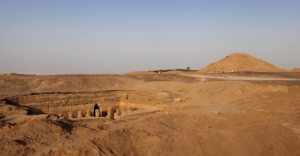Recently Discovered 'Ancient Graffiti' Explored In New U-M Kelsey Museum Of Archaeology Exhibition

Northern Sudan is mostly desert, but the Nile Valley in this region was once home to a powerful African civilization called Kush. It traded gold and the products of inner Africa to Egypt and the Mediterranean world beyond.
"Graffiti as Devotion along the Nile: El-Kurru, Sudan," now open at the University of Michigan Kelsey Museum of Archaeology, explores one part of private religious ritual in ancient Kush-the practice of carving graffiti in important and sacred places like pyramids and temples. This practice began during a time when Kush was ruled from the capital of Meroe (300 BCE to 300 CE), a city located along the Nile about 100 miles north of modern-day Khartoum.
The exhibition examines a series of newly discovered graffiti by a Kelsey Museum archaeological field project on a pyramid and in an underground temple at the site of El-Kurru.
"For us today, it's a strange idea that a visitor to a temple would carve a picture into the stone and that this would be an accepted, even valued, practice," said Geoff Emberling, co-curator of the exhibition, associate research scientist at the Kelsey Museum and co-director of the International Kurru Archaeological Project. "But in ancient Kush it was common, and graffiti can still be seen at several sacred sites: on the pyramids of Meroe; in a seasonal pilgrimage center called Musawwarat es-Sufra; and in the Temple of Isis at Philae, near the border with Egypt."
According to Emberling, the graffiti found at El-Kurru includes clear symbols of ancient Kush, like the ram that represented the local form of the god Amun, and a long-legged archer who symbolized Kushite prowess in archery. There are also intricate textile designs, as well as animals-beautiful horses, birds, camels and giraffes. The most common marks are small round holes gouged in the stone-by analogy with modern practices, these are likely the areas where temple visitors scraped the wall of the holy place in order to collect powdered stone that they would ingest to promote fertility and healing.
"Through photographs, text and interactive media presentations, this exhibition explores the times and places in which Kushite graffiti were inscribed," said exhibition co-curator Suzanne Davis, who is also an associate curator and head of conservation at the Kelsey Museum. "It also presents the 'afterlife' of Kushite devotion at El-Kurru, with reference to continuing use of the site as a pilgrimage destination."
Part of the exhibition highlights Kelsey conservators' work to preserve the graffiti. Using a computer interactive, visitors can manipulate images in order to examine the graffiti under a variety of lighting conditions. This type of documentation, called reflectance transformation imaging, or RTI, is one method archaeologists and conservators use to digitally preserve and study ancient, fragile surfaces like graffiti and rock art.
"Graffiti as Devotion along the Nile: El-Kurru, Sudan" will run until March 29, 2020, and is accompanied by an illustrated catalog that is is available to download or purchase. In addition, an online version of the exhibition is available.
The U-M Kelsey Museum of Archaeology is located at 434 South State St. in Ann Arbor, and is free and open to the public. Museum hours are 9 a.m.-4 p.m. Tuesday-Friday and 1-4 p.m. Saturday-Sunday (closed Mondays).
Photo Credit: Geoff Emberling
Comments
Videos

